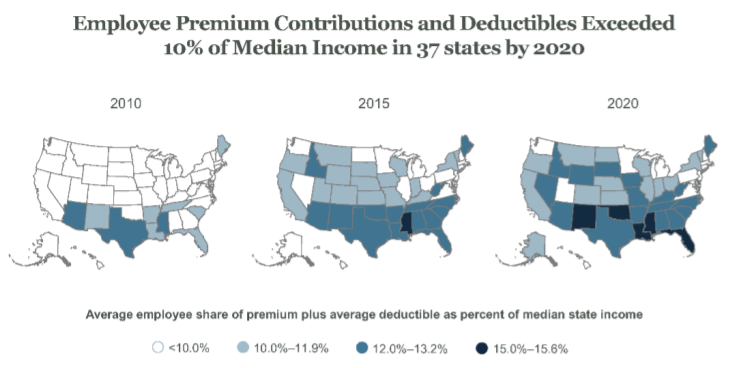New report says workers' health insurance, deductibles take up 10% or more of median income – User-generated content

Working families are shouldering an increasing share of health insurance costs as premiums and deductibles continue to rise.
Although employer health insurance coverage has proved to be relatively stable during the COVID-19 pandemic, the costs of that insurance consume a greater share of working families’ incomes in every state than they did a decade ago, a new Commonwealth Fund report finds.
According to the report, State Trends in Employer Premiums and Deductibles, 2010–2020, median incomes have not kept pace with rising health insurance costs and deductibles, which are fueled by high health care and drug prices.
The report is part of the Commonwealth Fund’s ongoing series that looks at state-level trends in the overall cost of employer health insurance. It provides a state-by-state analysis of how much insurance is costing workers in premiums, deductibles, and as a share of income, from 2010 to 2020.
Key findings include:
• Premium contributions and deductibles totaled 11.6 percent of median income in 2020, up from 9.1 percent in 2010. On average, employees’ premium costs amounted to 6.9 percent of income in 2020, an increase from 5.8 percent in 2010. The average annual deductible for a middle-income household amounted to 4.7 percent of income, compared to 3.3 percent in 2010. Together, the average total cost of premiums and potential deductible spending across single and family insurance policies climbed to $8,070. Costs ranged from a low of $6,528 in Hawaii to a high of more than $9,000 in Florida, Kansas, Missouri, South Dakota, and Texas.
• In a growing number of states, workers are at risk of spending 10 percent or more of their earnings on health insurance premiums and deductibles. In 2020, workers in 37 states passed that threshold, up from 10 states in 2010. Middle-income workers in Mississippi and New Mexico faced the highest potential costs relative to income (19% and 18%, respectively).
• In nearly half of states, middle-income households faced average deductibles that left them underinsured and exposed to high out-of-pocket costs. That’s up from only one state in 2010. The Commonwealth Fund defines one measure of “underinsured” as having a deductible equivalent to 5 percent or more of income. Underinsured people are more likely to struggle to pay medical bills and more likely to skip care because of costs. The highest average deductible relative to median income in 2020 was 7.4 percent, in New Mexico.
• Workers in lower-wage companies contribute more to family premiums than workers in higher-wage firms do. Workers in companies with lower average wages paid a larger share of their overall premium for family coverage, on average—and consequently a larger dollar amount—than workers in companies with higher average wages.
In Kentucky in 2020:
• Employee deductibles were $3,600 or about 6.1% of th state’s median income;
• Employee premium contributions were $4,37o or about 7.5% of the state’s median income.
Implications
Only about 6 percent of U.S. working-age adults reported losing their employer health insurance during the COVID-19 pandemic and few became uninsured— largely because of the critical supports provided by the Affordable Care Act’s (ACA) marketplace subsidies and expansions in Medicaid eligibility.
However, the financial burden of commercial insurance is an enduring problem that is undermining Americans’ economic well-being and causing many to forgo necessary medical treatment. If passed, the Build Back Better Act would make the most sweeping enhancements to the ACA since its passage in 2010. These include a substantial increase in marketplace premium subsidies, a lower affordability threshold for employer plans, and a new zero-premium marketplace coverage option for Medicaid-eligible adults without access to Medicaid in their states. However, these improvements only last through 2025.
The study authors suggest additional reforms to improve health insurance for U.S. workers, including:
• Addressing the high health care prices that are driving up employer premiums and deductibles; for example, by adding a public plan option to the marketplaces and other approaches.
• Informing workers with employer coverage about their options to enroll in subsidized marketplace plans or in Medicaid.
• Reining in deductibles and out-of-pocket costs in marketplace plans by enhancing cost-sharing reduction subsidies.
See the full report here.
The mission of The Commonwealth Fund is to promote a high-performing health care system that achieves better access, improved quality, and greater efficiency, particularly for society’s most vulnerable, including low-income people, the uninsured, and people of color. The Fund carries out this mandate by supporting independent research on health care issues and making grants to improve health care practice and policy.







